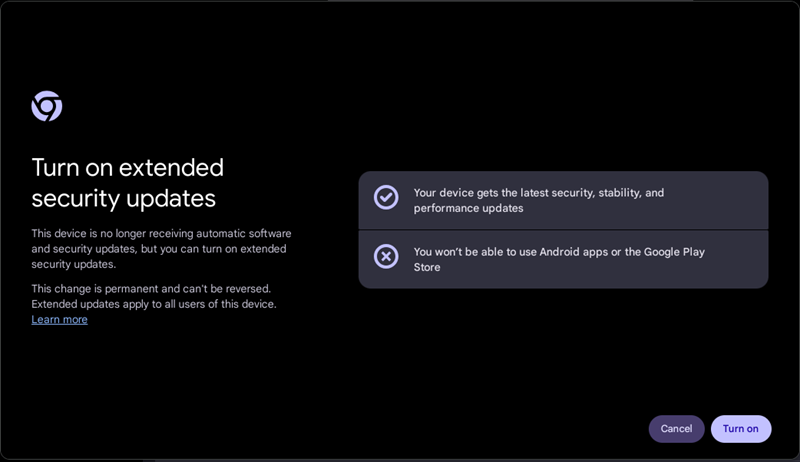In recent months, a wave of Chromebook users has found themselves without access to the Google Play Store and their favorite Android apps, all following a routine ChromeOS update. The issue, affecting a range of Chromebook models, has frustrated users who rely on Android apps for daily tasks like reading Kindle books, monitoring security cameras, and managing productivity.
For some, the culprit appears to be Google’s Extended Security Updates feature. Chromebook users are presented with a prompt to turn on these updates if their devices are no longer eligible for automatic software support. While it offers continued security and stability updates, it also comes with a significant trade-off: the permanent removal of Android app support and the Play Store. The warning is explicit: once users activate Extended Security Updates, they’ll lose access to Android apps and can’t reverse the decision.

However, some users claim they never opted into these updates, or they missed the implications of the message. Some report that they didn’t receive a prompt at all, only to find their Android apps gone after an automatic update. This has led to confusion and frustration, with users describing their Chromebooks as “useless” without access to the apps they’ve grown accustomed to.
Google’s Chromebook has a months-long thread with 258 upvotes as of this writing and plenty of complaints, and the tech giant is actively investigating the issue. Here’s a statement from August:
The chromeOS team is aware of the issue and is currently investigating it, we hope to have something to share soon’ish.
The problem seems especially prevalent among certain Chromebook models, like those on the “coral” baseboard, often indicated by the “ltc-channel” version label in device settings. Google’s product experts have advised affected users to attempt a “Powerwash and Revert” to return their devices to the last ChromeOS version that supported Android apps. However, this solution is limited, as it can only roll back one version; users who have updated multiple times since enabling Extended Updates must perform a full system Recovery, requiring them to install an older ChromeOS image that still supports Android apps.

In the meantime, Google is encouraging users to submit feedback with the hashtag #playstore to help gather data on the issue. For those who haven’t yet encountered this, the advice is clear: read update prompts carefully. The Extended Security Updates option is useful, but enabling it could mean saying goodbye to Android apps — permanently.
TechIssuesToday primarily focuses on publishing 'breaking' or 'exclusive' tech news. This means, we are usually the first news website on the whole Internet to highlight the topics we cover daily. So far, our stories have been picked up by many mainstream technology publications like The Verge, Macrumors, Forbes, etc. To know more, head here.
a guy20-05-2025
why Chrome os gotta do this to us
ReplyAbe06-05-2025
How on earth can being a "useful" update option render the majority of Google domestic user's Chromebooks unusable! One main reason we migrated away from MS & windows was their "update & patch" culture. Can you think of the environmental impacts alone that these stunts have on rendring hardware "obsolete" before its time
ReplyDale Tsai26-12-2024
It can be reinstalled, by using an USB or SD card to store original Chrome OS provided by Acer.
Reply


eric23-08-2025
I can still use older windows or apple and apps regardless the age and AOL for updates. This is crazy...all apps removed because of a update?
Reply